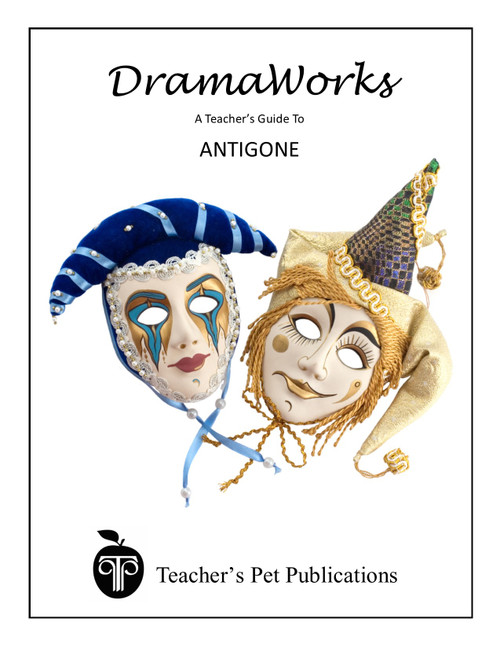Product Overview
CCSS Aligned! The focus of DramaWorks Guides is on having an interactive classroom with informative discussions and active participation by the students. DramaWorks are designed, to give teachers a working understanding of the play, in this instance A Midsummer Night's Dream, a high level of comfort in making an interesting and informative presentation of the play to their students, and a variety of activities at can be done in class and/or at home.
All activities come with suggestions for the teacher as well as directions for students. The activities include vocabulary exercises that focus on application of the words; classroom presentations; close examination of specially chosen parts of the text; acting exercises; writing assignments for the personal, interview, and research paper; and improvisations. There are, in addition, many suggested extra activities that allow students to practice skills in gathering and thinking about information, presenting information verbally, working with various media, and writing information in a variety of forms. Students also are encouraged to try to learn new skills such as the elements of acting.
Accompanying those materials are very practical suggestions for ways to allot classroom time for direct teaching, interactive discussions, and assigned activities, as well as ways to use out-of-class activities to the best advantage in furthering students’ understanding and enjoyment of the play.
Everything is presented in ways that conserves the teacher’s time and at the same time capitalizes on every opportunity to make the classroom interesting and dynamic. Many opportunities are given to actually “act out” parts of the play in class.
What is unique about DramaWorks is that it places emphasis on classroom teaching, discussion, and activity. We hope it gives teachers the confidence to create a dynamic, interactive classroom environment. We know it will help you to introduce A Midsummer Night's Dream to your students with minimal preparation but maximal results.
Because DramaWorks actually teaches users about the play while coaching them in teaching their students, it requires relatively little additional preparation time. There is no need to put hours and hours into creating lengthy lesson plans from scratch. And because it gives teachers many specific activities and suggestions about assigning them and often gives estimates regarding time required to carry them out, teachers can simply pick and choose from among many pre-designed activities without having to create new ones and to devise lengthy instructions for their students.
What the DramaWorks Guide Contains
The Guide contains several sections.
The first section is About the Playwright and His Art, which contains a brief write-up on the life and art of William Shakespeare.
Next is A Synopsis of A Midsummer Night's Dream that both teachers and students may use to gain a quick and easy understanding of the overall plot of the play. Although some teachers may object to giving students notes on the plot of the play because doing so seems somehow like “cheating,” we believe that it is very helpful for students to refer to. But, as with all of the parts of the Guide, teachers get to make the decision as to which parts to use and which not.
In the section entitled Learning and Teaching, really the heart of the Guide, teachers will learn about A Midsummer Night's Dream at the same time that they gain techniques for teaching the play to their students. There is information on choosing a good text, reading the play for enjoyment and for teaching preparation, considerable information about the play’s characters, plot, thematic ideas, costuming, props, and set, and interesting and informative ways to present those aspects of drama to students. Throughout this section, we talk with teachers and share our thoughts on each part of A Midsummer Night's Dream.
- Also included in Learning and Teaching are ways to act out parts of the play in the classroom using the sketchiest of props, sets, and costumes or no props, sets, or costumes at all. If teachers want to use the acting portions of the Guide, then the ideas in props, sets, and costumes will be very beneficial. Throughout the Learning and Teaching section, teachers will find many casual suggestions for activities that can be used with students at varying learning levels. What Learning and Teaching really is is a section of coaching for the teacher.
- As educators with many years of experience in a variety of settings with lots of different students, we try to give teachers as many ideas as possible for ways to learn about the play and to pass that learning along to their students in as dynamic and informative a way as possible. By combining their own ideas and methodology with ours, teachers will create a vast assortment of ideas, approaches, and teaching techniques.
- And that brings us to an important note: we don’t propose that our suggestions are the only way(s) to teach this or any other play. As teachers approach A Midsummer Night's Dream and other dramas, they will no doubt add notes, thoughts, and activities that will change their teaching over the years. What Learning and Teaching represents is a beginning, a variety of ways to approach A Midsummer Night's Dream that we believe will be successful in many classrooms.
- Following the Learning and Teaching section are a series of more formally presented activities. Some may be done with students at varying learning levels while others require substantially capable and interested students.
Vocabulary Words from the Text is designed to make students more familiar with the meanings of over 60 words from the play’s text. Each word is quoted as it is used in A Midsummer Night's Dream and is accompanied by a clear dictionary definition. Students apply the words in interesting ways to assist them in understanding and becoming more familiar with them. Some of these activities may be done individually at home and some may be done in pairs and small groups in class.
The section called Scenes for Modern Rewrites is intended primarily to combat the accessibility problems presented by language that is over 400 years old. But what teachers will find about the Rewrites section is that focusing so narrowly on individual scenes will open ways for teachers and students to discuss the play’s characters, plot, and major ideas. The Rewrites lend themselves to either individual or group work and should be approached as a fun activity, if at all possible.
The Written Word is included for teachers who are most comfortable with evaluating students through traditional writing assignments. There are multiple suggestions for writing based on personal experience, writing that evolves from investigation and research, and writing based on interviews. The writing itself is an individualized activity done by students either in or outside of the classroom, but in the interest of time, we assume that most of the writing will be completed at home.
The Exercises are of three types. Some ask for investigation followed by a classroom presentation. And because we are learning about drama, other exercises involve creating theatrical improvisations and presenting them in class while still others give students the opportunity to act out parts of the play in class with or without costumes, props, and sets. Some of the exercises can be done individually while some are group activities. The section was created to give teachers a wide choice of each type of activity.
The Exercises is a section that can be used in its entirety, in part, or not at all. Although we hope that teachers will use some of the activities in the section, it is entirely possible to teach A Midsummer Night's Dream interestingly and successfully without doing the exercises at all. Regardless of how they are used, it is unlikely that any classroom teacher will have the luxury of enough class periods to use the entire Exercises section.
One of the last sections is called More and More Activities, which includes a list of extra activities that teachers might want to consider. There are fifty activities listed. Many of them have multiple parts.
We conclude with The Epilogue and a note on the text.













